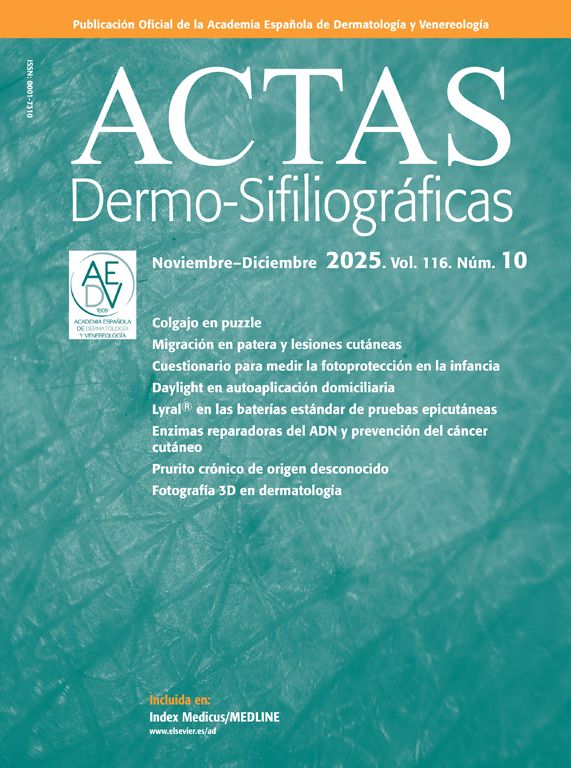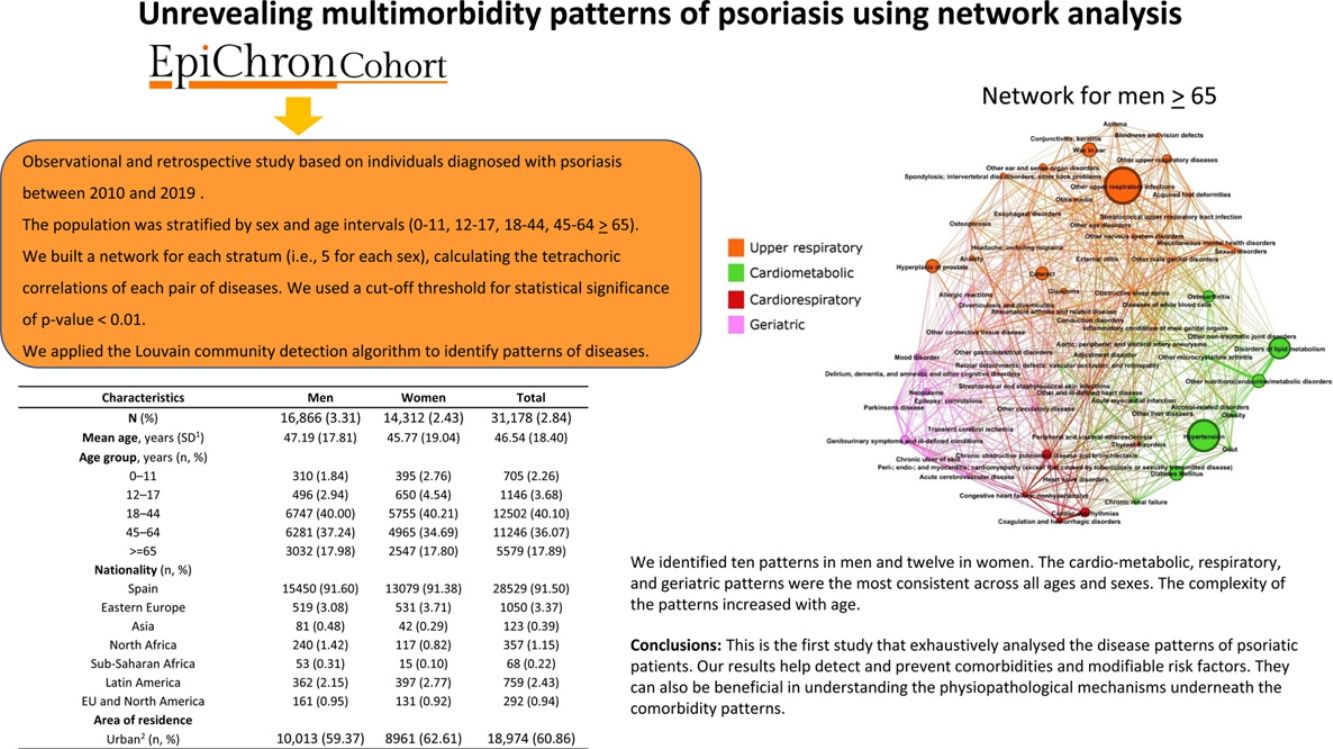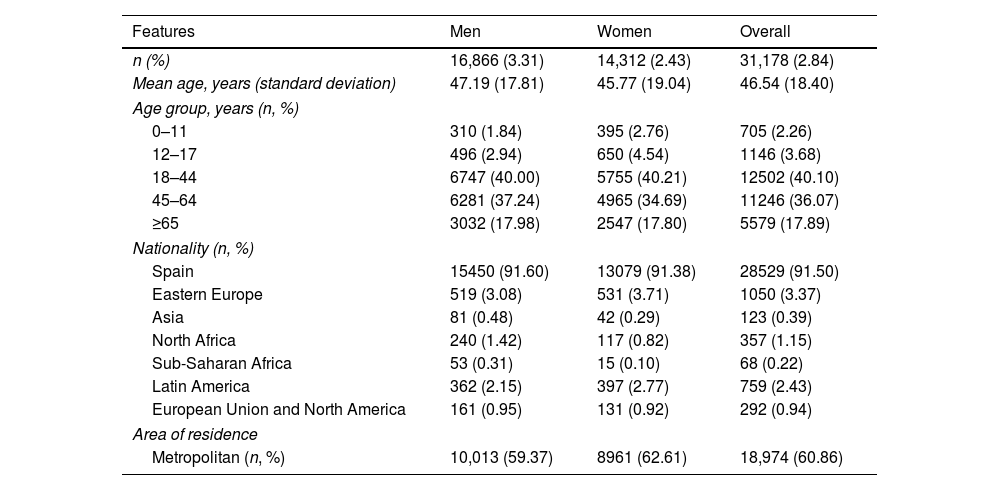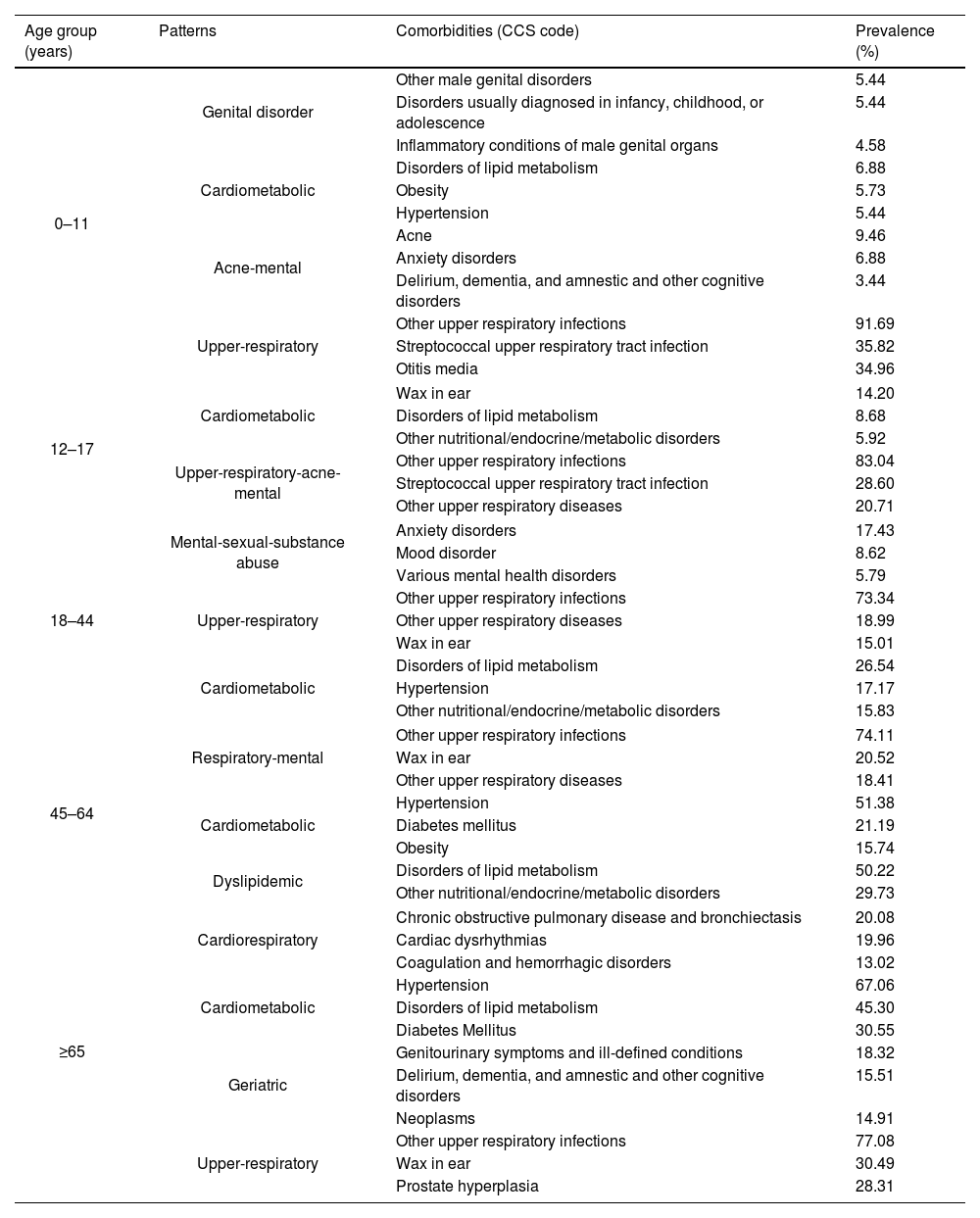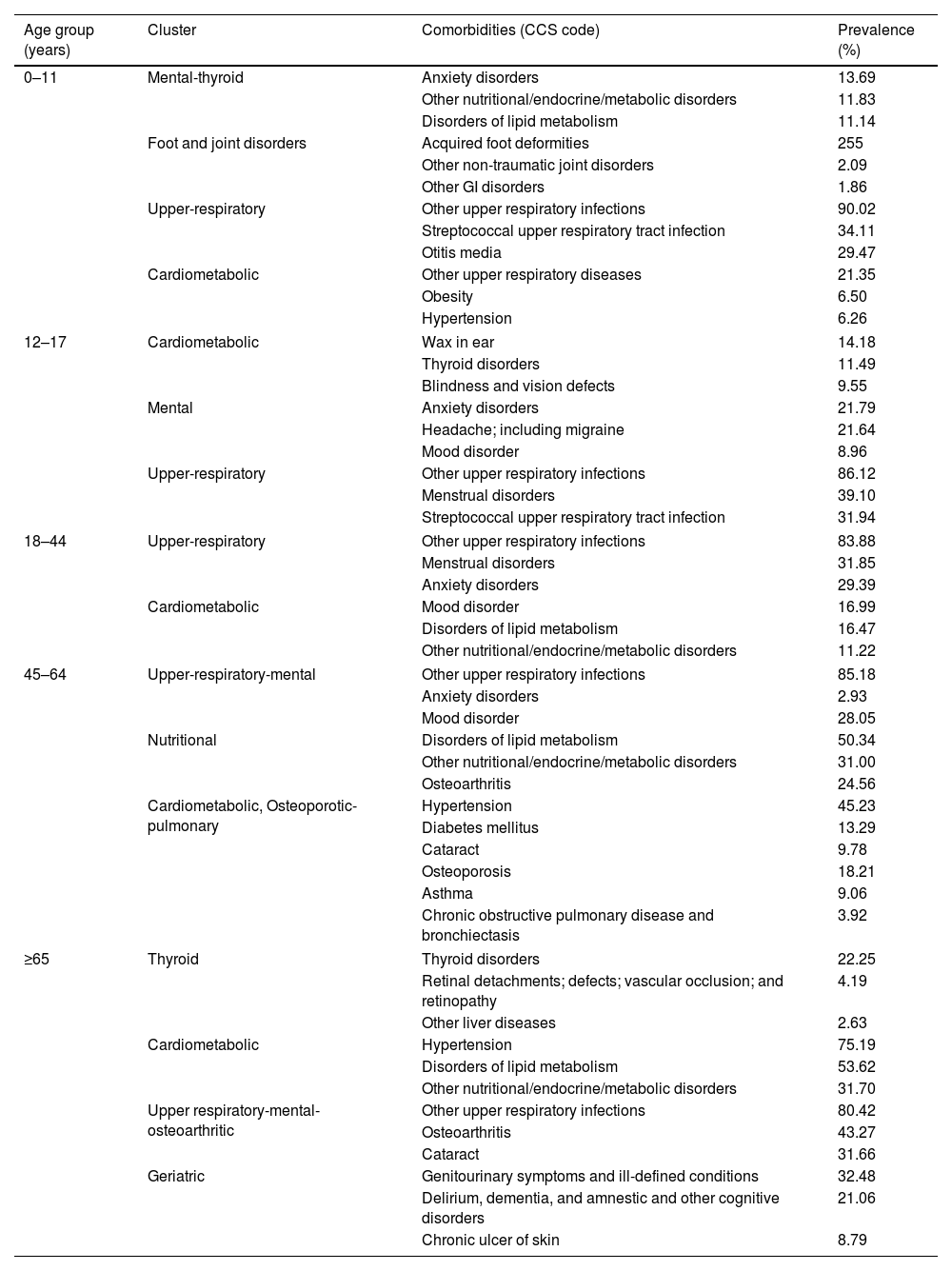Psoriasis is a chronic disease with a prevalence of 3% in the general population. The high prevalence of psoriasis has prompted the study of its comorbidities in recent decades. However, no studies have ever analyzed comorbidity patterns including all chronic diseases in psoriatic patients.
ObjectivesTo identify comorbidity patterns in psoriatic patients using network analysis and describe them from a clinical point of view.
MethodsWe conducted an observational and retrospective study with individuals of the EpiChron Cohort (Aragón, Spain) diagnosed with psoriasis from January 1st, 2010 through December 31st, 2019. The population was stratified by sex and age intervals (0–11, 12–17, 18–44, 45–64, ≥65). We built a network for each stratum (i.e., 5 for each sex), calculating the tetrachoric correlations of each pair of diseases. We used a cut-off threshold for statistical significance of p-value <0.01. We applied the Louvain community detection algorithm to identify clusters of diseases.
ResultsThe prevalence of psoriasis in Aragón was found to be 2.84%. We identified a total of 31,178 psoriatic patients (54% men, 61% from metropolitan areas). The most common comorbidities were respiratory diseases, cardiometabolic conditions (such as hypertension and dyslipidemia), and mental health disorders (including anxiety and mood disorders). A total of 21 comorbidity patterns were identified, varying by sex and age group.
ConclusionsThis is the first study ever conducted with a comprehensive analysis of the disease patterns of psoriatic patients. Our results are a comprehensive map of possible psoriasis-related comorbidities. Further studies should confirm these associations and their pathophysiological relationship with psoriasis, which could help to detect and prevent comorbidities and modifiable risk factors.
La psoriasis es una enfermedad crónica con una prevalencia del 3% en la población general. La alta prevalencia de la psoriasis ha impulsado el estudio de sus comorbilidades en las últimas décadas. Sin embargo, no se han realizado estudios que analicen los patrones de comorbilidades que incluyan todas las enfermedades crónicas en los pacientes con psoriasis.
ObjetivosIdentificar los patrones de comorbilidades en los pacientes con psoriasis utilizando análisis de redes y describirlos desde un punto de vista clínico.
MétodosEstudio observacional y retrospectivo basado en individuos de la Cohorte EpiChron (Aragón, España) con diagnóstico de psoriasis entre el 1 de enero de 2010 y el 31 de diciembre de 2019. La población se estratificó por sexo y rangos de edad (0-11, 12-17, 18-44, 45-64 y >65). Construimos una red para cada estrato (es decir, 5 para cada sexo), calculando las correlaciones tetracóricas de cada par de enfermedades. Utilizamos un umbral de corte para la significación estadística de p-valor<0,01. Aplicamos el algoritmo de detección de comunidades de Louvain para identificar los grupos de enfermedades.
ResultadosLa prevalencia de la psoriasis en Aragón fue del 2,84%, con 31.178 pacientes con psoriasis identificados (54% varones, 61% de áreas urbanas). Las comorbilidades más comunes fueron enfermedades respiratorias, enfermedades cardiometabólicas (como hipertensión y dislipidemia) y trastornos de salud mental (incluyendo ansiedad y trastornos del estado de ánimo). Se identificaron un total de 21 patrones de comorbilidad, que variaron según el sexo y el grupo de edad.
ConclusionesEste es el primer estudio que analiza exhaustivamente los patrones de enfermedades en los pacientes psoriásicos. Nuestros resultados representan un mapa exhaustivo de las posibles comorbilidades relacionadas con la psoriasis. En posteriores estudios deberán confirmarse estas asociaciones y su relación fisiopatológica con la psoriasis, lo que podría ayudar a detectar y prevenir las comorbilidades y los factores de riesgo modificables.
Psoriasis is an immune-mediated inflammatory disease (IMID) of multifactorial pathogenesis characterized by well-demarcated, erythematous, silvery scaly plaques or papules involving skin surfaces, nails, and outside joints.1,2 IMIDs are chronic and highly disabling diseases that share inflammatory sequences and immunological dysregulations.3 In Spain, the overall prevalence of the IMIDs is 6%, being psoriasis the most common disease (3%).3 The prevalence of psoriasis varies across countries, being more common in countries more distant from the equator and ranging from <1% up to 11%.4,5 Psoriasis can occur at any age but frequently develops its first signs during young adulthood and is most common in middle-aged individuals, with no clear differences between women and men.2 Evidence suggests its prevalence and incidence have increased worldwide, becoming a problem of global public health.4,6,7
Numerous studies have associated psoriasis with different diseases, such as psoriatic arthritis, metabolic syndrome, lung disease, non-alcoholic fatty liver disease, uveitis and mental health problems, while others remain unclear, such as insomnia or multiple sclerosis.8–11 Many psoriatic complications have been attributed to diet and obesity; nevertheless, it was recently hypothesized that psoriasis per se is a systemic inflammatory condition, leading to atherosclerosis and a higher risk of cerebrovascular and cardiovascular diseases.12 Most studies on psoriasis-related comorbidities focus on specific chronic diseases; however, chronic diseases do not appear isolated but tend to group in disease patterns, that is, non-random disease associations. As far as we know, only two studies have analyzed psoriasis-related comorbidity patterns while considering very few common chronic diseases the two of them.13,14 Better and more comprehensive knowledge of its comorbidities and specifically its disease patterns could help us improve our understanding of the underlying pathogenic mechanisms of psoriasis for a comprehensive management of psoriatic patients.
In this challenging context, network science is a powerful tool that comprehensively analyses and visualizes the associations among diseases, applying clustering methods to identify disease patterns.15 Network analysis has been applied to study disease patterns in patients with specific index conditions obtaining relevant clinical results.16,17 Nevertheless, as far as we know, this method has not been applied to the study of psoriasis-related multimorbidity.
This study aims to comprehensively analyze and identify the existence of comorbidity patterns in psoriatic patients using network analysis and describe the patterns obtained from a clinical standpoint.
MethodsStudy design and populationWe conducted an observational and retrospective study in the EpiChron Cohort. This cohort associated clinical and socio-demographic data from all users of the public health system of the Aragón region in Spain18; integrating clinical-administrative databases and electronic health records (EHRs) of nearly 98% of the citizens of Aragón (reference population 1.3M people). For this analysis, we included all 31,178 patients from the cohort diagnosed with psoriasis at one time or another from January 1st, 2010 through December 31st, 2019.
This research project was approved by the Clinical Research Ethics Committee of Aragón (CEICA) (Protocol PI23/608), while the requirement to obtain the patients’ informed consent was deemed unnecessary given the use of anonymized data and its epidemiological nature.
Study variablesFor each participant, we studied sex, age interval (0–11, 12–17, 18–44, 45–65, and >65 years), type of residence area (rural vs metropolitan), all chronic conditions and some acute diseases registered in their EHRs. Diagnoses were initially coded using the International Classification of Primary Care, First Edition (ICPC-1) and mapped to ICD-9-CM using a codifier system.19 Then, each ICD9-CM code was sorted into 226 different clinical categories using the Clinical Classifications Software (CCS),20,21 153 of which were categorized as chronic using the open-source tool chronic condition indicator (CCI).22 This tool defines as such those with a duration ≥12 months and has, at least, one of the following criteria: (a) demands continuous care, with a high risk of recurrence, and/or with implications for the management of the patients; (b) has limitations regarding self-care, independent living, and social interactions. The group's clinical experts reviewed and recoded the final list of 156 chronic clinical categories with minor changes to ease their clinical interpretation. The diseases studied were defined by the article as potential comorbidities.
Regarding acute diseases, we included those that the group's clinical experts considered clinically relevant. This list of acute conditions included was unspecified local infection of the skin and subcutaneous tissues (staphylococcal) (streptococcal) (ICD9-CM 686.9); streptococcal infections of the upper respiratory tract (ICD9-CM 034.0); other upper respiratory diseases (CCS 134, acute and chronic codes); other upper respiratory infections (CCS 126, except ICD9-CM 034.0, which was a separate category); allergic rhinitis (ICD9-CM 477); conjunctivitis (ICD9-CM 370 and 372.0); acne (ICD9-CM 706.0 and 706.1); otitis media (ICD9-CM 381 and 382); external otitis (ICD9-CM 380.1 and 380.2); ear wax (ICD9-CM 380.4).
Statistical analysisFirst, we performed a descriptive analysis of the demographic characteristics of the study population. Results were expressed as proportions for categorical variables and as means with standard deviations for continuous variables.
Then, network analysis was used to study the associations among psoriasis-related comorbidities. The population was stratified by age interval and sex, and we built a network for each stratum (10 networks overall). To ease result interpretation and increase the study clinical interest, we included diseases with prevalences ≥1% in the study.
Regarding the networks, a disease is represented by a node, and a link means a statistically significant correlation between a specific pair of diseases. Population was stratified by sex and age intervals (0–11, 12–17, 18–44, 45–64, >65). We built a network for each stratum (i.e., 5 for each sex). The tetrachoric correlations were calculated for each pair of comorbidities to analyze the weight of the association between them.23 A cut-off p-value <0.01 was used to correct the family wise-error rate due to multiple comparisons.16,17
Once the networks were built, we used their modularity to search for clusters of diseases based on the Louvain method,24 as it has been done previously in comorbidity pattern studies.16,17,25 Modularity considers the number of links in the network and compares the links density inside a group to the number of links across groups.24 Community detection algorithms such as the Louvain method allow the network structure to decide the size and number of clusters obtained based on the density of links and their weight, not by researchers.26,27 The Louvain algorithm optimizes modularity through an iterated process, detecting clusters or patterns of diseases.
Once we had the patterns of diseases for each stratum, clinicians named the patterns by consensus. We performed this last step considering the clinical relevance of diseases, their prevalence, the weight of tetrachoric correlations and based on the names already given by the scientific medical literature.
All analyses were performed using RStudio (version 1.4.1106, Rstudio, Boston, MA, United States) and GEPHI software packages (version 0.9.2).
ResultsCharacteristics of the populationWe studied a population of 31,178 psoriatic patients (54% men, 75% young and middle-aged adults, 61% from metropolitan areas). Their demographic characteristics are shown in Table 1. In Aragón (Spain), the overall prevalence of psoriasis was 2.84%.
Demographic characteristics of psoriatic patients.
| Features | Men | Women | Overall |
|---|---|---|---|
| n (%) | 16,866 (3.31) | 14,312 (2.43) | 31,178 (2.84) |
| Mean age, years (standard deviation) | 47.19 (17.81) | 45.77 (19.04) | 46.54 (18.40) |
| Age group, years (n, %) | |||
| 0–11 | 310 (1.84) | 395 (2.76) | 705 (2.26) |
| 12–17 | 496 (2.94) | 650 (4.54) | 1146 (3.68) |
| 18–44 | 6747 (40.00) | 5755 (40.21) | 12502 (40.10) |
| 45–64 | 6281 (37.24) | 4965 (34.69) | 11246 (36.07) |
| ≥65 | 3032 (17.98) | 2547 (17.80) | 5579 (17.89) |
| Nationality (n, %) | |||
| Spain | 15450 (91.60) | 13079 (91.38) | 28529 (91.50) |
| Eastern Europe | 519 (3.08) | 531 (3.71) | 1050 (3.37) |
| Asia | 81 (0.48) | 42 (0.29) | 123 (0.39) |
| North Africa | 240 (1.42) | 117 (0.82) | 357 (1.15) |
| Sub-Saharan Africa | 53 (0.31) | 15 (0.10) | 68 (0.22) |
| Latin America | 362 (2.15) | 397 (2.77) | 759 (2.43) |
| European Union and North America | 161 (0.95) | 131 (0.92) | 292 (0.94) |
| Area of residence | |||
| Metropolitan (n, %) | 10,013 (59.37) | 8961 (62.61) | 18,974 (60.86) |
The most prevalent diseases found in psoriatic patients were respiratory (i.e., upper respiratory infections and other upper respiratory diseases), cardio-metabolic (i.e., hypertension, dyslipidemia, obesity, diabetes, thyroid disorders and other nutritional/endocrine/metabolic disorders), and mental health diseases (i.e., anxiety, and mood disorders). Diseases were clustered into 21 patterns with sex and age specificities, which are summarized below. The output of the analysis is available as supplementary material.
Male comorbidity patternsWe identified a total of 10 male patterns, which were categorized as upper-respiratory, acne-mental, cardiometabolic, genital disorder, upper-respiratory-acne-mental, mental-sexual-substance abuse, respiratory-mental, dyslipidemic, cardiorespiratory, and geriatric patterns. Their composition, prevalence, and correlation between diseases are illustrated in Table 2 and Fig. 1.
Comorbidity patterns in men by age group with their three most prevalent diseases.
| Age group (years) | Patterns | Comorbidities (CCS code) | Prevalence (%) |
|---|---|---|---|
| 0–11 | Genital disorder | Other male genital disorders | 5.44 |
| Disorders usually diagnosed in infancy, childhood, or adolescence | 5.44 | ||
| Inflammatory conditions of male genital organs | 4.58 | ||
| Cardiometabolic | Disorders of lipid metabolism | 6.88 | |
| Obesity | 5.73 | ||
| Hypertension | 5.44 | ||
| Acne-mental | Acne | 9.46 | |
| Anxiety disorders | 6.88 | ||
| Delirium, dementia, and amnestic and other cognitive disorders | 3.44 | ||
| Upper-respiratory | Other upper respiratory infections | 91.69 | |
| Streptococcal upper respiratory tract infection | 35.82 | ||
| Otitis media | 34.96 | ||
| 12–17 | Cardiometabolic | Wax in ear | 14.20 |
| Disorders of lipid metabolism | 8.68 | ||
| Other nutritional/endocrine/metabolic disorders | 5.92 | ||
| Upper-respiratory-acne-mental | Other upper respiratory infections | 83.04 | |
| Streptococcal upper respiratory tract infection | 28.60 | ||
| Other upper respiratory diseases | 20.71 | ||
| 18–44 | Mental-sexual-substance abuse | Anxiety disorders | 17.43 |
| Mood disorder | 8.62 | ||
| Various mental health disorders | 5.79 | ||
| Upper-respiratory | Other upper respiratory infections | 73.34 | |
| Other upper respiratory diseases | 18.99 | ||
| Wax in ear | 15.01 | ||
| Cardiometabolic | Disorders of lipid metabolism | 26.54 | |
| Hypertension | 17.17 | ||
| Other nutritional/endocrine/metabolic disorders | 15.83 | ||
| 45–64 | Respiratory-mental | Other upper respiratory infections | 74.11 |
| Wax in ear | 20.52 | ||
| Other upper respiratory diseases | 18.41 | ||
| Cardiometabolic | Hypertension | 51.38 | |
| Diabetes mellitus | 21.19 | ||
| Obesity | 15.74 | ||
| Dyslipidemic | Disorders of lipid metabolism | 50.22 | |
| Other nutritional/endocrine/metabolic disorders | 29.73 | ||
| ≥65 | Cardiorespiratory | Chronic obstructive pulmonary disease and bronchiectasis | 20.08 |
| Cardiac dysrhythmias | 19.96 | ||
| Coagulation and hemorrhagic disorders | 13.02 | ||
| Cardiometabolic | Hypertension | 67.06 | |
| Disorders of lipid metabolism | 45.30 | ||
| Diabetes Mellitus | 30.55 | ||
| Geriatric | Genitourinary symptoms and ill-defined conditions | 18.32 | |
| Delirium, dementia, and amnestic and other cognitive disorders | 15.51 | ||
| Neoplasms | 14.91 | ||
| Upper-respiratory | Other upper respiratory infections | 77.08 | |
| Wax in ear | 30.49 | ||
| Prostate hyperplasia | 28.31 | ||
Comorbidity patterns in the networks of men with ‘psoriasis’ based on age. The diameter of each node and the label size are proportional to the disease prevalence. The width of each link is proportional to the correlation between diseases. The colors of the nodes correspond to different patterns.
In boys aged 0–11 years, we identified four multimorbidity patterns: upper-respiratory, acne-mental, cardiometabolic, and genital disorder patterns.
In boys aged 12–17 years, we found two main patterns: upper-respiratory-acne-mental pattern – similar to the one found in children 0–11 but also including other diseases such as acne, anxiety, mood disorders and headache – and a cardiometabolic pattern (including a more complex composition of diseases than the one reported in children aged 0–11).
In men aged 18–44 years, we identified three patterns: mental-sexual-substance abuse pattern, upper-respiratory pattern – similar to those found at earlier ages but without mental disorders – and cardiometabolic pattern.
In men aged 45–64 years, three patterns were identified: respiratory-mental pattern – including most diseases from the upper respiratory pattern and mental pattern of men aged 18–44 – cardiometabolic, and dyslipidemic patterns.
In men aged 65 and older, we found a total of 4 patterns: upper respiratory pattern – similar to that previously found but including other highly prevalent diseases such as hyperplasia of prostate or cataracts – cardiometabolic, cardiorespiratory, and geriatric patterns with urinary incontinence, dementia, mood disorders and neoplasms as the most prevalent conditions of this age stratum.
Female comorbidity patternsWe identified a total of 11 patterns in psoriatic women: upper respiratory, cardiometabolic, mental-thyroid, foot and joint disorders – non-traumatic – mental, upper-respiratory-mental, nutritional, osteoporotic-pulmonary, upper-respiratory-mental-osteoarthritic, thyroid, and geriatric patterns. Their composition, disease prevalence, and correlation across conditions are described in Table 3 and Fig. 2.
Comorbidity patterns in women by age group with their three most prevalent diseases.
| Age group (years) | Cluster | Comorbidities (CCS code) | Prevalence (%) |
|---|---|---|---|
| 0–11 | Mental-thyroid | Anxiety disorders | 13.69 |
| Other nutritional/endocrine/metabolic disorders | 11.83 | ||
| Disorders of lipid metabolism | 11.14 | ||
| Foot and joint disorders | Acquired foot deformities | 255 | |
| Other non-traumatic joint disorders | 2.09 | ||
| Other GI disorders | 1.86 | ||
| Upper-respiratory | Other upper respiratory infections | 90.02 | |
| Streptococcal upper respiratory tract infection | 34.11 | ||
| Otitis media | 29.47 | ||
| Cardiometabolic | Other upper respiratory diseases | 21.35 | |
| Obesity | 6.50 | ||
| Hypertension | 6.26 | ||
| 12–17 | Cardiometabolic | Wax in ear | 14.18 |
| Thyroid disorders | 11.49 | ||
| Blindness and vision defects | 9.55 | ||
| Mental | Anxiety disorders | 21.79 | |
| Headache; including migraine | 21.64 | ||
| Mood disorder | 8.96 | ||
| Upper-respiratory | Other upper respiratory infections | 86.12 | |
| Menstrual disorders | 39.10 | ||
| Streptococcal upper respiratory tract infection | 31.94 | ||
| 18–44 | Upper-respiratory | Other upper respiratory infections | 83.88 |
| Menstrual disorders | 31.85 | ||
| Anxiety disorders | 29.39 | ||
| Cardiometabolic | Mood disorder | 16.99 | |
| Disorders of lipid metabolism | 16.47 | ||
| Other nutritional/endocrine/metabolic disorders | 11.22 | ||
| 45–64 | Upper-respiratory-mental | Other upper respiratory infections | 85.18 |
| Anxiety disorders | 2.93 | ||
| Mood disorder | 28.05 | ||
| Nutritional | Disorders of lipid metabolism | 50.34 | |
| Other nutritional/endocrine/metabolic disorders | 31.00 | ||
| Osteoarthritis | 24.56 | ||
| Cardiometabolic, Osteoporotic-pulmonary | Hypertension | 45.23 | |
| Diabetes mellitus | 13.29 | ||
| Cataract | 9.78 | ||
| Osteoporosis | 18.21 | ||
| Asthma | 9.06 | ||
| Chronic obstructive pulmonary disease and bronchiectasis | 3.92 | ||
| ≥65 | Thyroid | Thyroid disorders | 22.25 |
| Retinal detachments; defects; vascular occlusion; and retinopathy | 4.19 | ||
| Other liver diseases | 2.63 | ||
| Cardiometabolic | Hypertension | 75.19 | |
| Disorders of lipid metabolism | 53.62 | ||
| Other nutritional/endocrine/metabolic disorders | 31.70 | ||
| Upper respiratory-mental-osteoarthritic | Other upper respiratory infections | 80.42 | |
| Osteoarthritis | 43.27 | ||
| Cataract | 31.66 | ||
| Geriatric | Genitourinary symptoms and ill-defined conditions | 32.48 | |
| Delirium, dementia, and amnestic and other cognitive disorders | 21.06 | ||
| Chronic ulcer of skin | 8.79 | ||
Comorbidity patterns in the networks of women with ‘psoriasis’ based on age. The diameter of each node and the label size are proportional to the disease prevalence. The width of each link is proportional to the correlation between diseases. The colors of the nodes correspond to different patterns.
In girls aged 0–11 years, a total of four patterns were found: upper-respiratory pattern – which was similar to the one described in boys of the same age but including menstrual disorders and acne – cardiometabolic, mental-thyroid, and foot and joint disorders – non-traumatic – patterns.
In women aged 12–17 years, a total of three patterns were found: upper respiratory, cardiometabolic, and mental patterns.
In women aged 18–44 years, a total of two patterns were found: upper respiratory and cardiometabolic patterns, which were similar to the ones found in younger women. Mental diseases were divided so that mood disorders were included in the cardiometabolic pattern and anxiety in the upper respiratory one.
In women aged 45–64 years, we found an total of four patterns: upper-respiratory-mental pattern – which combined most diseases from the upper respiratory one and the mental one, and also including other conditions such as thyroid and menstrual disorders – cardiometabolic, nutritional, and osteoporotic-pulmonary patterns.
In women aged >65, we found a total of four patterns: upper respiratory-mental-osteoarthritic pattern – which combined these three groups of diseases – cardiometabolic pattern, thyroid, and geriatric patterns.
DiscussionA better understanding of the pathogenesis of psoriasis has made us consider it a systemic chronic inflammatory disease.28–30 However, it is unclear how they impact each other.29,31
This study explored and identified the existence of different comorbidity patterns in psoriatic patients using a network analysis approach, which allowed us to identify different associations across comorbidities based on sex and age. Different clusters defined as cardio-metabolic, upper-respiratory, respiratory-mental, dyslipidemic, geriatric, genital disorders, among others, were identified based on age and gender. These clinical–epidemiological findings can help guide psoriatic patients in the primary, secondary, or even tertiary prevention of their comorbidities and shed some light on the understanding of the physiopathological mechanisms behind the existence of some disease associations.
The present research shows the cardiometabolic pattern as the most consistent one across all age groups and sexes. Cardiometabolic diseases have been associated with psoriasis in several epidemiological studies.31–33 Several studies have demonstrated that psoriatic patients – particularly younger patients and those with psoriatic arthritis or more severe forms of the disease – have a higher prevalence of metabolic syndrome and an increased risk of major cardiovascular events such as cerebrovascular disease, myocardial infarction, and peripheral arterial disease.34–36 The cardiometabolic pattern was more common in men across all ages in our study, although this pattern also appeared in women of adult age. The existence of this pattern confirms that psoriatic patients have comorbidities that are related to cardiovascular risk factors that tend to be associated throughout life.
Current evidence suggests that the association between psoriasis and cardiovascular disease is due to the underlying chronic inflammation present in both conditions.34 Observational studies confirm an independent relationship between moderate-to-severe psoriasis and certain risk factors for cardiovascular disease, including diabetes mellitus,37,38 hypertension,39 obesity12,40 and dyslipidemia.41 Furthermore, multiple epidemiological studies support the association between psoriasis and metabolic syndrome or some of its components, such as abdominal obesity, hypertriglyceridemia, and low levels of high-density lipoprotein.30,33,40,42 Augustin et al.,43 conducted the first spatiotemporal association between psoriasis prevalence and comorbidities in Germany, and the results indicated comparable spatial prevalence patterns for hypertension, obesity and type II diabetes mellitus. This means that the highest prevalence of comorbidities used to be found where the prevalence of psoriasis is higher.
On the other hand, thyroid metabolic disorders have also been associated with psoriasis. Recently, a meta-analysis showed a possible association between psoriasis and autoimmune thyroid disease. This meta-analysis of 11 available studies with data from 253,313 psoriatic patients and 1,376,533 controls showed that psoriatic patients had a higher prevalence of autoimmune thyroid disease vs controls (OR, 1.76, 95% CI, 1.35–2.28, Z=4.25; p <0.01).44
In children, it has been reported that there is an upper respiratory pattern, probably due to superantigens, some part of virus or bacteria proteins, which stimulate T cells and antigen-presenting cells, leading to systemic immune repose and inflammation, that can act as a trigger among the youngest.45 Two meta-analyses highlighted the relationship between psoriasis and COPD, suggesting that there is a strong association between these two chronic inflammatory diseases.46,47 It is thought that psoriasis-induced systemic inflammation acts de novo on respiratory organs, thus amplifying the preexisting chronic inflammation due to underlying diseases such as asthma or COPD. Two meta-analyses highlighted the relationship between psoriasis and COPD, suggesting that there is a strong association between these two chronic inflammatory diseases.46–49
The most common comorbidities in psoriatic patients are mental disorders, in particular affective disorders such as depression and anxiety, which can interact negatively with psoriasis and lead to a dangerous vicious circle.50 Depression in psoriatic patients has traditionally been explained as a response to psychosocial factors and impaired quality of life. Nevertheless, a new hypothesis linking depression and psoriasis through chronic inflammation offers insights that could help understand and treat these diseases. In this new approach, new drugs and lifestyle play an important role.51,52
In a similar way to what happens in the microenvironment of the skin, in the nervous system, the inflammatory response is maintained through the interaction between cytokine-receptors and cytokine-producing elements, such as microglia, astrocytes and oligodendrocytes.53 The hypothesis explains the connection between the neuroendocrinal and the immune system alterations that occur in certain forms of depression.
In patients older than 65 years, a geriatric-pattern was found in both sexes. Studies also show that there is a correlation between cognitive impairment and psoriasis.54 Psoriatic patients exhibit higher rates of mild cognitive impairment (44% vs. 11% in the controls; p=0.002),55 and individuals with a past medical history of psoriasis also have a higher odds ratio (OR) of dementia vs those without the disease (adjusted OR, 1.46, 95% CI, 1.23–1.73; p <0.001).56
Regarding the limitations of this study, the fact that the clinical information obtained from the EHRs was not originally designed for research, could have led to over- and under-diagnosis of some chronic disorders. Another limitation is the cross-sectional retrospective design of the study, with which there is no way of knowing about the longitudinal characteristics of the population or establishing cause-effect relationships. Chronic diseases associated with psoriatic patients were defined in our study as potential comorbidities. Our research establishes a map of diseases for future research without the ability to establish a direct physiopathological relationship with psoriasis. Additionally, we should consider the lack of some variables that could help us explain the results obtained, such as the severity of psoriasis, lifestyle information, socioeconomic factors, information on functional status, and analytical variables, among others.
One of the main strengths of our study is that we analyzed a population-based cohort, including 98% of the reference population. Moreover, data from the EpiChron Cohort undergoes continuous quality control checkups ensuring its accuracy and reliability for research purposes. Another important strength is the innovative method applied to understand comorbidities in psoriasis. Network analysis studies the interrelations across diseases and how patterns emerge from them. This paper shows the potentiality of applying this method to study and visualize the comorbidities of psoriasis and achieve a more holistic understanding of these patients. Of note, this study comprehensively analyzed all chronic diseases obtained from the patient's EHRs created by health professionals, and not just the most relevant, prevalent or self-reported diseases.
This is the first population-based study unraveling the comorbidity patterns of psoriatic patients through the network analysis of virtually all chronic conditions. We identified and described up to 10 and 11 patterns in men and women, respectively, whose complexity increased with age. These patterns included diseases from all systems and organs, which support the need for an interdisciplinary and comprehensive management of psoriasis. Our results are especially important for dermatologists so they can become aware of the high comorbidity burden of psoriasis, as well as for all health professionals having to deal with psoriasis in their everyday practice. Further studies are needed and encouraged to validate the results obtained across different clinical settings and populations and characterize the physiopathological mechanisms underlying the comorbidity patterns identified.
CRediT authorship contribution statementConceptualization, Y.G., J.C.-P., M.A.-B., and A.G.-M.; methodology, J.C.-P.; formal analysis, J.C.- P.; data curation, B.P.-P.; writing – original draft preparation, M.A.-B. and J.C.-P.; writing – review and editing, M.A.-B., J.C.-P., T.G.-C., B.P.-P., C.L.-B., A.M.-J., A.N.-B., A.G.-M., and Y.G.; visualization, J.C.-P.; supervision, A.G.-M. and Y.G.; funding acquisition, J.C.-P. and Y.G. All authors have read and agreed to the published version of the manuscript.
Ethical approvalEthical approval for this study was obtained from the Clinical Research Ethics Committee of Aragón (CEICA) that approved the research protocol for this study (PI23/608).
FundingThis research was funded by Instituto de Salud Carlos III, Ministry of Science and Innovation (Spain), through the Network for Research on Chronicity, Primary Care, and Health Promotion (RICAPPS) awarded on the call for the creation of Health Outcomes-Oriented Cooperative Research Networks (grant number RD21/0016/0019), and by Gobierno de Aragón (grant No. B01_23R) and co-funded by the European Union NextGenerationEU funds. The sponsors were not involved in the study design, data collection and analysis, decision to publish, or drafting of the manuscript.
Conflict of interestThe authors have no conflict of interest to declare.
AcknowledgmentsThe authors want to thank AMGEN for the financial support for the publication of this study.
Data availabilityThe data used in this study cannot be publicly shared, because of restrictions imposed by the Aragon Health Sciences Institute (IACS) and asserted by the Clinical Research Ethics Committee of Aragon (CEICA, ceica@aragon.es). The authors can establish future collaborations with other groups based on the same data. Potential collaborations should be addressed to the Principal Investigator of the EpiChron Group, Antonio Gimeno-Miguel, agimenomi.iacs@aragon.es.
